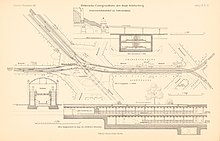Nollendorfplatz underground station
The Nollendorfplatz U-Bahn station is the only U-Bahn station where all four U-Bahn lines (U1 to U4) of the small-profile trains of the Berlin U-Bahn stop. The train station at Nollendorfplatz in Berlin district of Schoeneberg the district Tempelhof-Schöneberg consists of a high station with a large dome structure on which the features of U2 hold, and a two-storey underground station ( U1 , U3 , U4 ). The two underground platforms are one above the other and are connected by stairs. The U1 and U3 trains in the direction of Warschauer Straße stop at the upper platform, the U4 trains return on the southern platform in the direction of Innsbrucker Platz , the U1 trains in the direction of Uhlandstraße and the U3 trains in the direction of Krumme Lanke stop at the lower platform .
history
The Nollendorfplatz elevated station was opened in 1902 as a station on Berlin's first elevated railway line, the main line . It was designed by architects Wilhelm Cremer and Richard Wolffenstein . It is the last elevated station on this route to the west. From Kleiststrasse - at Courbièrestrasse - the subway disappears underground as a subway.
Between 1908 and 1910, the then independent city of Schöneberg built its Schöneberg subway (today: line U4). For this reason, a temporary train station was rebuilt in a paved area on Nollendorfplatz, with a direct transition to the train station of the same name. During the construction of this temporary station, the bones of prehistoric animals were found in Motzstrasse .
When the Schöneberg subway station was built, the construction of a parallel relief line north of the main line was planned. Therefore, as early as 1915, the preparatory work for the conversion of the Nollendorfplatz station into a community station began.
It was not until 1926 that the new subway, running under Kurfürstenstrasse , was opened. Together with the two new underground levels, a new station vestibule designed by Alfred Grenander was opened. At the same time, the Schöneberg train station was closed and only serves as part of the underground tunnel.
The elevated station was badly damaged in the Second World War and then rebuilt in a greatly simplified manner without the dome. The construction of the wall interrupted the route in the eastern sector towards Pankow (Vinetastraße) in front of the Potsdamer Platz underground station .
The underground tracks were extensively rebuilt in 1971. The direct connection between the tracks in the direction of Innsbrucker Platz (U4) and Warschauer Brücke (U1) was interrupted, instead a parking and sweeping system was set up north of the station. At the same time, a bunker system on the lower platform, which had existed since 1940, was dismantled and the exposed track trough was used for the first time for trains on the U4.
In 1972, the BVG ceased operations at the Nollendorfplatz high station together with the route along Bülowstraße to Gleisdreieck , as the low number of passengers no longer made profitable operation.
Instead, the flea market "Berlin Flea Market" moved into the elevated platforms , where discarded subway cars served as sales space. Since a Turkish bazaar was being built in the neighboring and also unused Bülowstrasse station , BVG had a type TM 36 middle-entry tramway shuttle on the elevated railway line between the two stations . For this purpose, the northern track was given a single contact line, and a short platform was set up on the other outside the station halls. It was the last tram route in West Berlin for the time being .
Since 1989 a memorial plaque on the south side of the facade of the station has been commemorating the homosexual victims of National Socialism . It was the first public memorial for this group of victims in a German city.
After the fall of the Berlin Wall in 1989, the flea market had to give way to the reopened U2 line to Pankow in 1993 , and the tram system was also dismantled. Between 1999 and 2002 the dome structure of the high station was rebuilt in a simplified form , exclusively with donations (around 300,000 euros ). The architect of the 30 meter high steel structure was Ralf Schüler .
The route between Mohrenstrasse and Wittenbergplatz was restarted on November 13, 1993.
In 2001 the BVG built a glazed control center for passenger information in the ground floor hall of the high station; the control center continues with a glass extension under the ramp of the elevated railway in the direction of Wittenbergplatz .
Both the high and underground stations are under monument protection . This also includes the Nickelmann fountain located at the western end under the underground arch of the elevated railway .
View of the tunnel towards Wittenbergplatz
Memorial plaque at the subway station to the homosexual victims of National Socialism
Connection
In addition to the four underground lines stopping here, the underground station offers transfer options to the M19, 106 and 187 bus lines operated by the Berliner Verkehrsbetriebe.
literature
- Axel Mauruszat: Reconstruction at Nollendorfplatz / planning and construction of the shared station of the subway. In: Verkehrsgeschichtliche Blätter , Volume 39, No. 2 (March / April 2012), pp. 34–39.
- Susanne Twarda: The Nollendorfplatz in Berlin . Motzbuch, Berlin 2001, ISBN 3-935790-02-3 .
Web links
Individual evidence
- ↑ Thomas Beckmann: Deadly - dead silent. 30 years of Rosa Winkel at Nollendorfplatz in Berlin . In: HuK -Info 206 (2019), p. 23.
- ↑ Marcus Böttcher, Volkmar Otto (photos): Well coupled . In: Berliner Zeitung , May 10, 2017, p. 14.
- ↑ Printed matter 17/12491. (PDF; 85 kB) Berlin House of Representatives, September 3, 2013, accessed on September 25, 2013 .
Coordinates: 52 ° 29 '58.6 " N , 13 ° 21' 14.1" E











